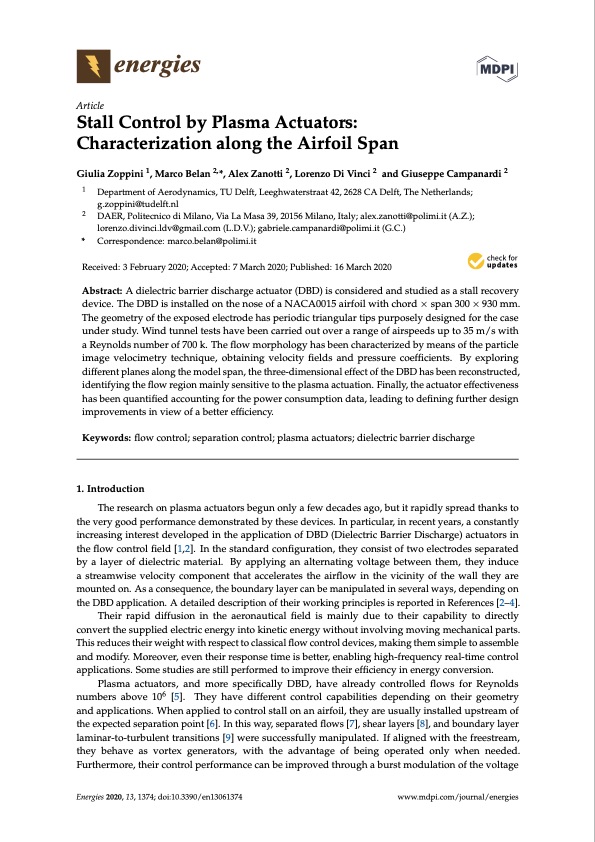
PDF Publication Title:
Text from PDF Page: 001
energies Article Stall Control by Plasma Actuators: Characterization along the Airfoil Span Giulia Zoppini 1, Marco Belan 2,*, Alex Zanotti 2, Lorenzo Di Vinci 2 and Giuseppe Campanardi 2 1 Department of Aerodynamics, TU Delft, Leeghwaterstraat 42, 2628 CA Delft, The Netherlands; g.zoppini@tudelft.nl DAER, Politecnico di Milano, Via La Masa 39, 20156 Milano, Italy; alex.zanotti@polimi.it (A.Z.); lorenzo.divinci.ldv@gmail.com (L.D.V.); gabriele.campanardi@polimi.it (G.C.) 2 * Correspondence: marco.belan@polimi.it Received: 3 February 2020; Accepted: 7 March 2020; Published: 16 March 2020 Abstract: A dielectric barrier discharge actuator (DBD) is considered and studied as a stall recovery device. The DBD is installed on the nose of a NACA0015 airfoil with chord × span 300 × 930 mm. The geometry of the exposed electrode has periodic triangular tips purposely designed for the case under study. Wind tunnel tests have been carried out over a range of airspeeds up to 35 m/s with a Reynolds number of 700 k. The flow morphology has been characterized by means of the particle image velocimetry technique, obtaining velocity fields and pressure coefficients. By exploring different planes along the model span, the three-dimensional effect of the DBD has been reconstructed, identifying the flow region mainly sensitive to the plasma actuation. Finally, the actuator effectiveness has been quantified accounting for the power consumption data, leading to defining further design improvements in view of a better efficiency. Keywords: flow control; separation control; plasma actuators; dielectric barrier discharge 1. Introduction The research on plasma actuators begun only a few decades ago, but it rapidly spread thanks to the very good performance demonstrated by these devices. In particular, in recent years, a constantly increasing interest developed in the application of DBD (Dielectric Barrier Discharge) actuators in the flow control field [1,2]. In the standard configuration, they consist of two electrodes separated by a layer of dielectric material. By applying an alternating voltage between them, they induce a streamwise velocity component that accelerates the airflow in the vicinity of the wall they are mounted on. As a consequence, the boundary layer can be manipulated in several ways, depending on the DBD application. A detailed description of their working principles is reported in References [2–4]. Their rapid diffusion in the aeronautical field is mainly due to their capability to directly convert the supplied electric energy into kinetic energy without involving moving mechanical parts. This reduces their weight with respect to classical flow control devices, making them simple to assemble and modify. Moreover, even their response time is better, enabling high-frequency real-time control applications. Some studies are still performed to improve their efficiency in energy conversion. Plasma actuators, and more specifically DBD, have already controlled flows for Reynolds numbers above 106 [5]. They have different control capabilities depending on their geometry and applications. When applied to control stall on an airfoil, they are usually installed upstream of the expected separation point [6]. In this way, separated flows [7], shear layers [8], and boundary layer laminar-to-turbulent transitions [9] were successfully manipulated. If aligned with the freestream, they behave as vortex generators, with the advantage of being operated only when needed. Furthermore, their control performance can be improved through a burst modulation of the voltage Energies 2020, 13, 1374; doi:10.3390/en13061374 www.mdpi.com/journal/energiesPDF Image | Stall Control by Plasma Actuators: Characterization along the Airfoil Span

PDF Search Title:
Stall Control by Plasma Actuators: Characterization along the Airfoil SpanOriginal File Name Searched:
energies-13-01374.pdfDIY PDF Search: Google It | Yahoo | Bing
NFT (Non Fungible Token): Buy our tech, design, development or system NFT and become part of our tech NFT network... More Info
IT XR Project Redstone NFT Available for Sale: NFT for high tech turbine design with one part 3D printed counter-rotating energy turbine. Be part of the future with this NFT. Can be bought and sold but only one design NFT exists. Royalties go to the developer (Infinity) to keep enhancing design and applications... More Info
Infinity Turbine IT XR Project Redstone Design: NFT for sale... NFT for high tech turbine design with one part 3D printed counter-rotating energy turbine. Includes all rights to this turbine design, including license for Fluid Handling Block I and II for the turbine assembly and housing. The NFT includes the blueprints (cad/cam), revenue streams, and all future development of the IT XR Project Redstone... More Info
Infinity Turbine ROT Radial Outflow Turbine 24 Design and Worldwide Rights: NFT for sale... NFT for the ROT 24 energy turbine. Be part of the future with this NFT. This design can be bought and sold but only one design NFT exists. You may manufacture the unit, or get the revenues from its sale from Infinity Turbine. Royalties go to the developer (Infinity) to keep enhancing design and applications... More Info
Infinity Supercritical CO2 10 Liter Extractor Design and Worldwide Rights: The Infinity Supercritical 10L CO2 extractor is for botanical oil extraction, which is rich in terpenes and can produce shelf ready full spectrum oil. With over 5 years of development, this industry leader mature extractor machine has been sold since 2015 and is part of many profitable businesses. The process can also be used for electrowinning, e-waste recycling, and lithium battery recycling, gold mining electronic wastes, precious metals. CO2 can also be used in a reverse fuel cell with nafion to make a gas-to-liquids fuel, such as methanol, ethanol and butanol or ethylene. Supercritical CO2 has also been used for treating nafion to make it more effective catalyst. This NFT is for the purchase of worldwide rights which includes the design. More Info
NFT (Non Fungible Token): Buy our tech, design, development or system NFT and become part of our tech NFT network... More Info
Infinity Turbine Products: Special for this month, any plans are $10,000 for complete Cad/Cam blueprints. License is for one build. Try before you buy a production license. May pay by Bitcoin or other Crypto. Products Page... More Info
| CONTACT TEL: 608-238-6001 Email: greg@infinityturbine.com | RSS | AMP |